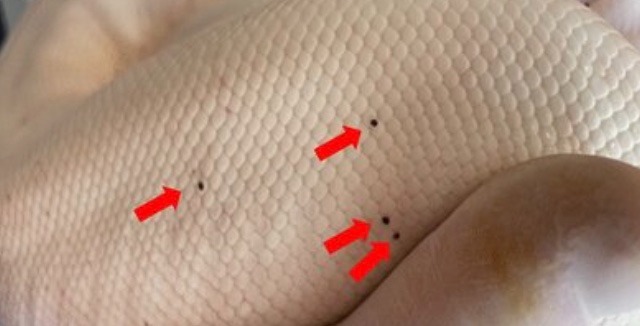The Dreaded Snake Mites: Origins, Treatment, and Prevention
Emerald City Reptiles
7/30/20255 min read


Understanding Snake Mites: Origins and Infestation Causes
Snake mites, scientifically known as Ophionyssus natricis, are parasitic arthropods that primarily target snakes. The origins of these pests can be linked to their natural habitats, where they thrive in the wild by residing in the ecosystems that snakes occupy. These habitats typically provide an optimal environment for the mites, allowing them to feed and reproduce effectively. When snakes are kept in captivity, the risk of snake mite infestations increases significantly, as the mites can inadvertently be introduced into enclosures through various means.
One common source of infestation is the introduction of new snakes into an existing habitat. This can occur during the acquisition of new reptiles from suppliers or private collections, who may unknowingly carry mites. Furthermore, environmental factors such as shared housing or equipment, including terrariums, bedding, or even clothing and hands can facilitate the transfer of snake mites. Their resilience is a notable characteristic, as they can survive for extended periods without a host, making them a persistent nuisance for snake keepers.
The life cycle of snake mites consists of several stages, including egg, larva, nymph, and adult. Each stage is crucial for their development, with females laying eggs in close proximity to the host snake. This life cycle plays a significant role in the rapid population growth of mites, which can quickly lead to a severe infestation if not managed promptly. Additionally, their ability to adapt to varied environments makes them a formidable adversary for both novice and experienced reptile enthusiasts.
In conclusion, understanding the origins of snake mites and their infestation causes is paramount for effective management. Their ecological adaptability combined with the dynamics of captive environments positions snake mites as a common challenge for snake owners. Addressing these factors early on can prevent significant repercussions for both the snakes and their caretakers.
Signs of Snake Mite Infestation: Identifying the Problem
Detecting a snake mite infestation is crucial for the health and well-being of your pet. One of the primary physical symptoms that might indicate the presence of snake mites is irritation on the skin of the snake. Owners should look for signs such as excessive rubbing against surfaces, which can suggest that the snake is trying to alleviate discomfort caused by these external parasites. A common indicator of mite issues is also noticeable shedding. While snakes naturally shed their skin periodically, an increase in shedding frequency or inconsistent shedding patterns could be a red flag for potential mite infestation.
Another critical sign is the observation of the mites themselves. These parasites are typically small and can be difficult to spot; however, they may appear as tiny black or brown specks moving on the skin. To effectively assess for snake mites, it is advisable for owners to conduct a thorough inspection of both the snake and its habitat. This involves examining the snake closely, particularly around the head, neck, and underbelly, where mites tend to congregate. In addition to inspecting the snake, the environment must also be scrutinized. An area with high humidity and warmth can be conducive to a mite infestation.
Owners should be vigilant in checking for any signs of discoloration or unusual spots on the snake's skin, as these may correlate with mite activity. Additional symptoms can include increased aggression or lethargy, which may signal that the snake is struggling with discomfort. Awareness of these signs is crucial for effective mite management. If any of these symptoms are detected, it is essential to consult a veterinarian specializing in reptiles to confirm the presence of mites and to discuss appropriate treatment options. Early detection and action can significantly improve the outcome for your reptilian companion.
Effective Treatment Processes for Snake Mites
Combatting snake mites requires a multifaceted approach, incorporating both chemical and natural treatment methods to effectively eradicate these pests. It is essential to start with a thorough inspection of the affected snakes, as well as their habitats, to determine the extent of the infestation. Once identified, a combination of treatments can be employed to ensure maximum efficacy.
Chemical treatments are often the first line of defense against snake mites. Several reputable products are available, including veterinary-approved insecticides specifically formulated for reptiles. A commonly recommended chemical treatment is permethrin, which can effectively kill mites on contact. When using such products, it is crucial to follow the manufacturer's instructions meticulously regarding dosage and application frequency. Typically, the treatment involves spraying the solution on the snake and its habitat, ensuring it covers all surfaces.
In addition to chemical treatments, natural remedies can also be beneficial. Essential oils, such as clove or tea tree oil, have been cited for their mite-repelling properties. Mixing these oils with a carrier oil and applying them to the snake's skin or using them in the environment may help reduce mite populations. Before using any natural solution, it is important to consult with a veterinarian familiar with reptile care to avoid adverse reactions.
Cleaning the snake's habitat is a critical component of the treatment process. This entails removing all substrate, disinfecting enclosures with an appropriate reptile-safe cleaner, and replacing it with fresh materials. Ensuring that all hiding spots and decorations are also cleaned will minimize the risk of re-infestation. After the initial treatment, follow-up care is essential. This includes regular inspections of both the snake and its environment, maintaining a clean habitat, and repeating treatments as necessary to ensure that the snake mites have been fully eradicated.
Preventing Future Infestations: Quarantining New Animals
To effectively prevent snake mite infestations in your collection, it is critical to adopt a quarantining protocol for any new snakes before they are introduced into the established environment. Quarantine acts as a vital buffer, allowing you to monitor new arrivals for the presence of mites and other pests, thereby safeguarding your existing reptile population. The recommended duration for this quarantine period is a minimum of 30 days, although extending it to 60 days is advisable, especially if you observe any signs of infestation.
During this quarantine phase, environmental controls are essential in minimizing risks. Place new snakes in a separate room, ideally with no shared ventilation system, to limit the potential spread of mites. Use a dedicated set of tools, including feeding equipment and habitats, that are specifically designated for the quarantine area. This cautious approach ensures that no cross-contamination occurs between new and existing snakes.
In addition to creating a physical separation, closely monitor the new snakes for any signs of mites, which may include excessive scratching or the presence of tiny black specks on their skin. Regularly inspect their habitats and substrates. It is advisable to keep the enclosure clean and use paper towels as a substrate, as it allows for easier observation and identification of potential pests.
Implementing a thorough veterinary check-up during the quarantine period is also beneficial. A professional examination can help identify any underlying health issues and assess the risk of mite infestation. Furthermore, practice strict hygiene measures after handling new animals. Wash hands thoroughly and sanitize any equipment used during the introduction process.
By adopting these essential quarantine measures, reptile keepers can significantly reduce the risk of introducing snake mites into their collections, thus promoting a healthy and thriving environment for their snakes.
#BallPythonGenetics #ReptileBreeding #EmeraldCityReptiles #BallPythons #KnowYourMorphs #SnakeBreedingBasics
Blog / Ball Pythons
Explore our insights on ball python breeding.
CONTACT
Sign Up for Updates no spam
info@ecreptiles.com
© 2025. Emerald City Reptiles All rights reserved.


